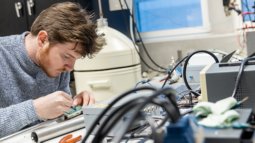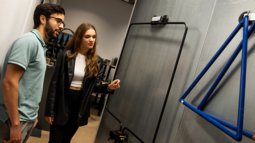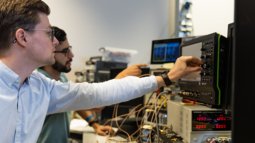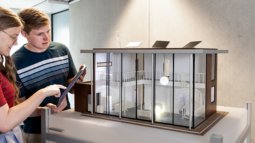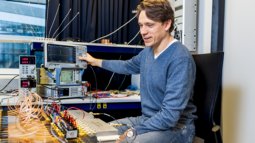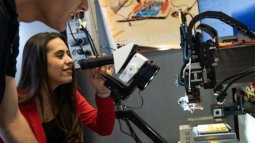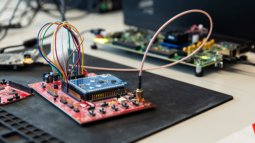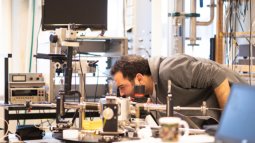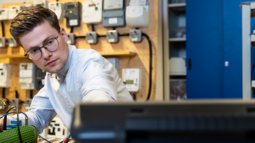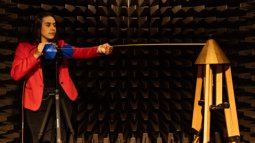Shape the future of electronics by developing novel electronic devices and systems, from circuits to sustainable energy technologies.
Electrical engineering is the foundation of technological progress in many fields, such as healthcare, manufacturing, transportation, aerospace, and the automotive industry. Do you want to push the boundaries of what is possible in electrical engineering? Think of innovating chip architecture, researching alternative components to replace transistors in current electronic devices, and making 3D printed sensors. What about improving medical imaging technologies, such as MRI and X-rays, along with developing implantable and wearable medical devices? Electrical engineering also plays a pivotal role in the ongoing energy transition, offering you immense opportunities to contribute to our future. You can enhance solar cell efficiency, facilitate sustainable chip manufacturing processes, and optimise power grids for compatibility with renewable sources like solar and wind energy. If you want to engage in impactful research and innovative technologies that will shape the future of electronics, the Master’s in Electrical Engineering at the University of Twente is the right choice for you!
In this two-year, English-taught Master’s, you will research, design, analyse, develop, and optimise electrical components and systems for a wide range of applications, such as smartphones, computers, medical devices, power grids, vehicles, or manufacturing processes. This Master’s places a strong emphasis on signal processing and analysis as well as on the design and development of electrical components and systems. You will have the opportunity to contribute to the advancement of technologies like solar cells, AI-assisted pattern recognition, and smart sensors.
Start Master’s in Electrical Engineering
You can start your studies in September or February. If you need to follow the Pre-Master's first, you can only start in September and continue with your Master's in February.
Choose a specialisation
You have a lot of freedom to customise your Master’s in Electrical Engineering to your interests and ambitions. Do you want to explore wireless communication and sensing systems? Or does the biomedical aspect of electrical engineering pique your curiosity? Perhaps you are eager to optimise the efficiency of energy systems or to innovate integrated circuit designs. Have you considered delving into nanoscale device and system development? Within this Master’s, you will develop a unique expertise in a specific domain by choosing one of the eleven specialisations. Your choice determines what courses you will take and the research in your master’s thesis. You can opt for one of the following specialisations or combine two:
Biomedical Signals and Systems
Engineering healthcare hardware to tackle sensory and motor dysfunction is crucial, especially amid ongoing health crises. In the specialisation in Biomedical Signals & Systems, you will learn to develop smart technologies enabling precise measurements and closed-loop control through implantable and wearable devices
2 yearsFull-timeEnglish
Communication Networks
This specialisation teaches you to design, develop, and secure evolving network systems encompassing wired, wireless, cloud computing, or the Internet of Things (IoT) networks. You will learn the intricacies of enhancing their connectivity, efficiency, security, and reliability
2 yearsFull-timeEnglish
Computer Vision and Biometrics
Can you make financial transactions more secure by using sensors to visualise vein patterns in a finger? How can you design unbiased electronic systems that work equally well for all individuals despite their skin tone, gender, or physical disabilities? In this specialisation, you will learn to address critical challenges in biometric data security.
2 yearsFull-timeEnglish
Dependable Integrated Systems
How can you develop robust and reliable computing systems capable of withstanding failures at any time? In this specialisation, you will learn techniques to ensure secure, uninterrupted services in critical applications, such as flight control systems, electronic health records, and smart grids.
2 yearsFull-timeEnglish
Integrated Circuit Design
If you choose the specialisation in Integrated Circuit Design, you will focus on designing chips that revolutionise connectivity, sustainability, and energy efficiency. You will address challenges in scaling down electronic components while enhancing power and energy conservation.
2 yearsFull-timeEnglish
Integrated Optical Systems
Optical systems offer numerous advantages for electrical engineering, such as energy efficiency, cost-effectiveness, and minimised heat generation. In this specialisation, you will learn to develop advanced optical systems that enable faster and more sustainable communication systems, sensors, and medical imaging.
2 yearsFull-timeEnglish
Micro Sensors and Systems
How can you engineer advanced micro sensors and integrated micro systems, such as MEMS, lab-on-a-chip, and 3D printed devices? Micro sensors are crucial components in smartphones, medical equipment, robotic systems, chemical plants, and safety systems. In this specialisation, you will learn how to make them and extract valuable information from them.
2 yearsFull-timeEnglish
Nano Electronics
Do you want to create innovative nanoscale electronic devices that can potentially lead to future generations of electronics with reduced power usage, extended battery life, and improved electrical conductivity? In this specialisation, you will address the newest challenges in designing nanoscale electronic devices and circuits.
2 yearsFull-timeEnglish
Power Electronics
Power electronics plays a vital role in our daily life, from converting solar energy to electricity to powering our electric vehicles. Yet, the increasing energy demand is raising serious environmental concerns. The specialisation in Power Electronics offers you the opportunity to address global challenges by designing more efficient and reliable power electronics and energy storage systems.
2 yearsFull-time
Radio Systems
Wireless Radio Frequency (RF) technologies are used in healthcare (e.g. heart and breath rate monitoring), environmental monitoring (e.g. insect tracking and biodegradable sensor networks) and connectivity (e.g. 5G and 6G). In this specialisation, you will learn to design and analyse RF systems that will make a difference.
2 yearsFull-timeEnglish
Semiconductor Devices and Technology
To meet the growing demand for electronics, it is imperative to explore sustainable approaches. In this specialisation, you will focus on enhancing semiconductor device performance, prioritising energy efficiency, and fostering sustainability through innovative materials and technologies.
2 yearsFull-time
Career perspectives
Electrical engineers are in high demand across many industries, such as healthcare, energy, aerospace, manufacturing, and telecommunications. Your expertise in designing, developing, and optimising electrical devices and systems will open up a variety of career opportunities in both the public and private domains. You can find a job at technology giants, IC design houses, semiconductor and microelectronics manufacturers, power plants, renewable energy companies, aerospace centres, research and development institutions, and security firms, among others. Most alumni secure a job well before graduating.
Job opportunities for electrical engineers
There is a growing need for electrical engineers with strong research skills and specialised technical knowledge in electrical systems. You will find a wide range of career opportunities including roles such as a design and process engineer, control systems engineer, data analyst, biomedical engineer, or research and development scientist. You can also opt for a career in academia and do a PhD at a university anywhere in the world. Or you can start your own company!
Programme overview
Related programmes
Below you find a list of educational programmes which are (closely) related to Electrical Engineering.
Engineering & Technology
Applied Mathematics
In this Master’s, you will apply mathematics to challenging issues in diverse sectors. You will learn how to discover new patterns and how to predict them through mathematical models.
Applied Physics
Deepen your understanding of the laws of physics to find technical solutions in a wide range of areas such as IT, sustainability, healthcare, chip design, digitalisation, finance, space and more.
Biomedical Engineering
Contribute to better healthcare by designing and developing medical innovations for improved diagnostics, treatment, rehabilitation, prevention and a better quality of life.
Business Information Technology
Become an expert in IT-based business innovation, able to devise new services and radically improve the way businesses work with the use of IT.
Chemical Science & Engineering
This Master’s will help you to develop novel chemical processes, materials and molecules and contribute to innovations that benefit our society in areas such as health, water, food and sustainability.
Civil Engineering & Management
If you are eager to focus on both the technical and non-technical aspects of civil engineering projects and systems, then the Master’s in Civil Engineering & Management is the programme for you.
Computer Science
In this Master’s, you will learn to solve the biggest challenges of tomorrow’s digital society by designing and developing more secure, scalable, and efficient ICT systems.
Construction Management & Engineering
This Master’s helps you to become an expert in managing large-scale, complex construction projects in an increasingly digitised industry, using an innovative, holistic approach.
Embedded Systems
This Master’s programme equips you with expertise in designing the software and hardware of complex embedded systems in vehicles, pacemakers and chipsets amongst others.
Humanitarian Engineering
Combine engineering and sociocultural knowledge in creating sustainable, impactful solutions to promote well-being in underserved communities.
Industrial Design Engineering
Combine design and engineering in creating innovative products that enrich people’s lives. During this two-year Master’s, you learn to optimise both products and the development processes involved.
Industrial Engineering & Management
Become a creative, multidisciplinary manager with both technological know-how and engineering and management skills and optimise processes and solve problems in complex, globally active organisations.
Interaction Technology
Delve into the field of human-computer interaction and design and develop interactive technologies that are meaningful to people and society.
Mechanical Engineering
Become an expert mechanical engineer that focuses on the futureproof design, analysis and maintenance of machinery, structures, products and production processes.
Nanotechnology
Tackle big, societal issues at the smallest level: become an expert in the upcoming field of nanotechnology and invent, design, and develop innovative solutions on the extremely small nanoscale.
Philosophy of Science, Technology & Society
Philosophy of Science, Technology & Society is the premier Master's programme for learning how to critically analyse and assess the impact of scientific and technological developments on society.
Robotics
In this Master’s, you will learn to create robots that fit seamlessly in society, industry, and healthcare, revolutionising quality of life, safety, and efficiency.
Spatial Engineering
Natural disasters, poverty, food shortage, epidemics, climate change: learn to tackle society’s greatest and complex challenges using spatial data and technical and socio-economic knowledge.
Sustainable Energy Technology
Do you feel called upon to make a valuable contribution to the sustainable energy transition? Become an expert in the development, implementation and integration of sustainable energy technologies.
Technical Medicine
This Dutch-taught Master’s will equip you to become a technical doctor who can use medical technologies to their full potential.

